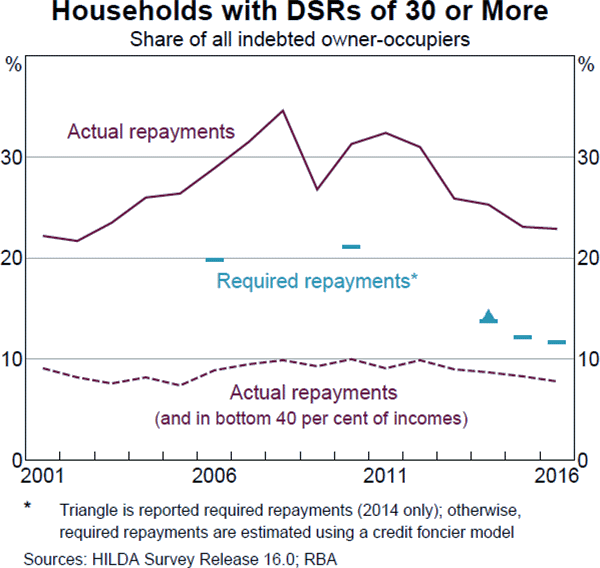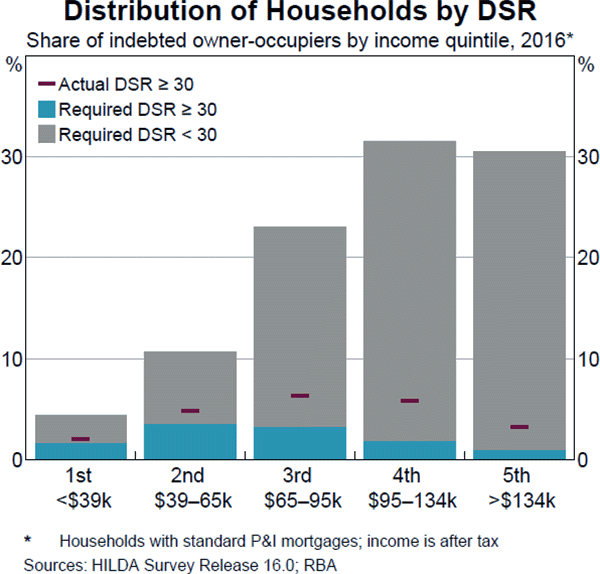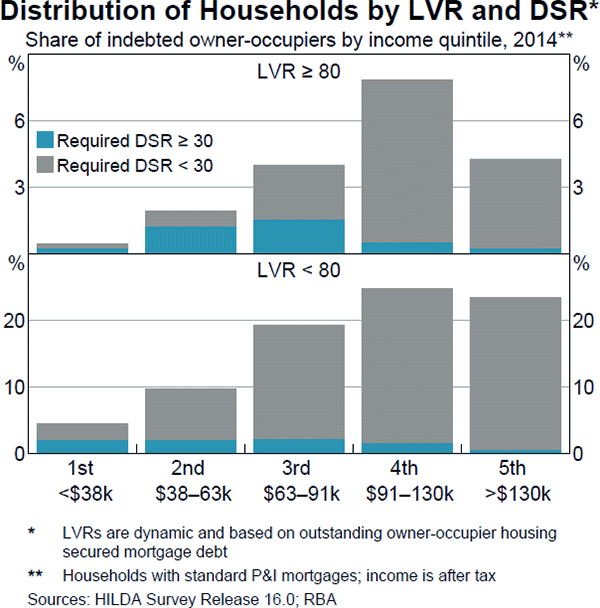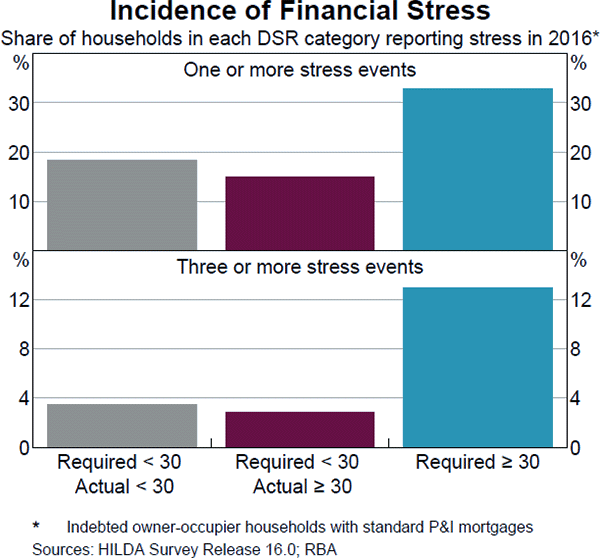Financial Stability Review – October 2018 Box C: Vulnerable Households and Financial Stress
Aggregate measures of debt repayments as a share of household income have remained around historical averages over recent years. However, as always, some indebted households are stretched by their mortgage repayments. Currently, these are a low share of the total. This box examines these vulnerable households over time, with a focus on indebted owner-occupiers. It also considers the extent to which these households exhibit other indicators of vulnerability, such as high loan-to-valuation ratios or measures of financial stress.
High repayments do not always indicate vulnerability …
There are a number of ways to identify vulnerable households who might struggle to service their mortgage debt. A common measure of vulnerability is the share of household income that is used for loan repayments, which is termed the debt servicing ratio (DSR). A DSR of 30 per cent or more is widely used as an indicator of potential housing stress. This simple measure, however, overlooks the fact that living expenses do not increase one-for-one with income and so higher-income households can afford a higher DSR (see ‘Box B: The Impact of Lending Standards on Loan Sizes’). The Household Income and Labour Dynamics in Australia (HILDA) survey suggests that the share of all indebted owner-occupiers with a DSR greater than 30 per cent increased during the early 2000s. It remained a bit under one-third of all households for much of the post-crisis period, although the share has fallen back in recent years as interest rates have declined (Graph C1).

One limitation of measured DSRs as a marker of stress is that they include voluntary additional repayments. Household surveys (such as HILDA or the Census) ask about ‘usual repayments’ to service debt rather than asking about required repayments. Actual repayments can overstate household vulnerability when they include voluntary prepayments into offset accounts and redraw facilities. These prepayments increase the share of income used to service a mortgage. But they also indicate that a household has spare cash flow. In other words, the household is undertaking additional saving. Households making excess repayments are less vulnerable as they are accumulating a pool of funds that they could draw on to service future debt repayments.
It is possible to calculate alternative DSRs using inferred values for households' required debt payments. Using the HILDA data, this requires some assumptions about initial loan terms and interest rates. This alternative DSR measure should give a better indication of the share of households experiencing stress from the debt repayments they have to make. It indicates that only around 12 per cent of indebted owner-occupiers spent 30 per cent or more of their income meeting their required mortgage obligations in 2016 (Graph C1). This is roughly half the share for whom actual mortgage repayments (required plus voluntary) made up 30 per cent or more of their income.
… but high required repayments on a low income can point to housing stress
Regardless of whether DSRs are based on actual or required repayments, vulnerability to housing stress is typically higher for lower-income households. Lower-income households usually use a greater share of their income for basic living expenses. A high DSR is therefore more suggestive of potential vulnerability for a lower-income household.
One commonly used yardstick of housing stress that focuses on lower-income households is the ‘30–40’ rule. This classifies a household as in stress if it has a DSR above 30 per cent and it is also in the bottom 40 per cent of the income distribution. Applying this rule using required debt servicing repayments suggests that around 5 per cent of indebted owner-occupier households could have been classified as facing housing stress in 2016 (Graph C2). This compares with around 7 per cent of households when applying the 30–40 rule using actual repayments. This share has been fairly stable over time (Graph C1).
Households with high required DSRs only make up a relatively small share of all indebted owner-occupiers, but they represent a more sizable share of those on lower incomes. In 2016 these borrowers comprised around two-fifths of all indebted owner-occupier households in the first income quintile and one-third of households in the second quintile. Relatively few households in the bottom two quintiles have mortgages, but those that do have less spare income to make substantial voluntary prepayments than those on higher incomes. As a consequence, their actual and required repayments are fairly similar and the proportions of households with a DSR above 30 per cent using either measure are similar.

The HILDA survey can also show the share of indebted owner-occupier households with high DSRs that have a large mortgage relative to the property value. Households with a high loan-to-valuation ratio (LVR) have greater risk as they are less likely to be able to pay off their mortgage by selling if property prices fall. Owner-occupier mortgagors in the HILDA survey with a required DSR above 30 per cent are twice as likely as other households to have an LVR above 80 per cent. In 2014, households with this combination only made up around 4 per cent of all indebted owner-occupiers. But of households with an LVR above 80 per cent, one-fifth had a required DSR greater than 30 per cent (Graph C3). Most of these households were concentrated in the second and third income quintiles. These households typically have newer mortgages and so have had less time to pay down debt or accumulate prepayments, or to benefit from housing price growth.

A high debt burden is linked to financial stress, but the situation of most households improves over time
Households with a high debt servicing burden are more likely to exhibit other signs of financial stress. The HILDA survey asks respondents if they have experienced any of seven different stress events over the previous twelve months because of a shortage of money. These stress events include being unable to pay bills on time or heat a home, needing to pawn something or having to ask family for money.
Owner-occupiers with a required repayment DSR above 30 per cent are considerably more likely to report incidences of financial stress (Graph C4). Around one-third of these households reported one or more incidences of financial stress compared with less than one-fifth of households with lower DSRs. Households with an actual DSR above 30 per cent (but a required DSR less than 30 per cent) report fewer incidences of financial stress, indicating they generally have the financial capacity to make the additional repayments if required. This suggests that using a DSR larger than 30 per cent as a measure of housing stress is more informative when based on required repayments rather than actual repayments. Even then, around two-thirds of households with a required DSR above 30 per cent reported no stress events at all.

Nonetheless, while households with a DSR above 30 per cent appear more vulnerable than other mortgagors, they also tend to pay down their debt and thereby reduce their debt burden over a fairly short period. Less than half of households with a DSR above 30 per cent in 2014 were still in that state by 2016. The speed of transition to a lower DSR and LVR for these individual households depends partly on interest rates, housing prices and income growth. Overall, the indebted owner-occupiers with a DSR above 30 per cent in 2014 improved their financial position by 2016 (the latest available data).
Although median outstanding mortgage debt only declined marginally, household income rose by around one-fifth, and the median required DSR fell by the same degree.[1] However, as the debt burden of these households declines, a new cohort of borrowers come along with new mortgages, a small number of whom have a high DSR and high LVR at loan origination and hence can be potentially vulnerable to economic shocks.
Footnotes
Income for these households may grow strongly because a household member earns a promotion, or a second income-earner re-enters the workforce. [1]